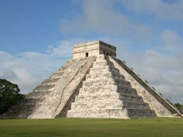About Mexico
About Mexico
 Situated in North America, Mexico identifies more closely with central and south America . The word Mexico is derived from ‘Mexica', the name for the indigenous group that settled in central Mexico in the early fourteenth century. It is located in Middle America, with the Gulf of Mexico to its east and the Pacific Ocean to its west. It has a long coast line of 9,330 km, and the national territory measures more than 750,000 square miles.
Situated in North America, Mexico identifies more closely with central and south America . The word Mexico is derived from ‘Mexica', the name for the indigenous group that settled in central Mexico in the early fourteenth century. It is located in Middle America, with the Gulf of Mexico to its east and the Pacific Ocean to its west. It has a long coast line of 9,330 km, and the national territory measures more than 750,000 square miles.
Mexico has varied terrain. It is flanked by two majestic mountain ranges known as the Sierra Madre. The Sierra Madre Oriental is on the east and the Sierra Madre Occidental on the west, they run north to south. The east and west of the chains are strips of coastal plains. Northern Mexico is a desert. The states of Sinaloa , Chihuahua , and Nuevo Leon are covered by these deserts. The most dominant feature of the Mexican topography is the Mexican plateau. It occupies most of the width of the country. The plateau falls to low Isthumus of Tehuantepec and then rises to Chipas Highland to the south. Mexico has nearly 150 rivers out of which 2/3 empty into the Pacific Ocean . The largest lake in Mexico is Lake Chapala , covering about 1686 sq km.
Mexican climate varies from tropical to desert type of climate. A tropical climate is experienced in the coastal regions of the Yucatan peninsula and lower areas of southern Mexico , while a temperate climate may be experienced in elevated areas. Though most of Mexico is dry with around 14% of the land receiving inadequate rainfall, the coasts suffer from hurricanes during summers and autumn. Central and south Mexico is also prone to earthquakes.
Mexico City the national capital, located in the heart of Mexico , was also the capital of the Aztec Empire. Mexico City today is the second largest city in the world with 97,361,711 inhabitants according to year 2000 population census. The principal ethnic majority is of the Mestizos who constitute 55% of the Mexican population. The Amerindians account for 30%, while 15% of the population is divided among whites and a small number of black Africans. The growth rate of the country has slowed, but the population is still very young. Mexico 's population still consists of many Indian groups. The most significant groups are the Nahuas, Otomis, Mayas, Zapotecas, Mixtecos, Tzeltales, and Tzotziles.
Most Mexicans are roman Catholics, which is around 89%, another 6% are protestants and 5% others.